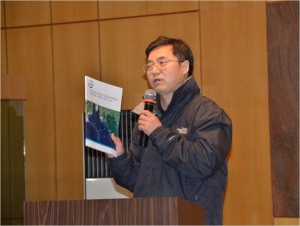January 23, Beijing – the Chinese version report of the IUCN situation analysis on East and Southeast Asian intertidal habitats, with particular reference to the Yellow Sea (including the Bohai Sea) was launched together by the International Union for Conservation of Nature (IUCN) and the Partnership for the East Asian – Australasian Flyway (EAAFP).
The report was commissioned jointly by the IUCN Species Survival Commission and IUCN Asia Regional Office to develop a situation analysis of the state and condition of intertidal habitats along the East Asian-Australasian Flyway (EAAF). “The report is in response to growing concerns expressed by IUCN members over observed declines in biodiversity, the loss of ecological services, and an increase in ecological disasters across the EAAF. It presents vast science-based information and illustrates a clear picture of the status of the intertidal zone in the EAAF, which could inform the decisions and actions of a wide range of stakeholders”, said Dr. Zhu Chunquan, IUCN China Country Representative.
The report finds that there is cause for significant concern over the status of the intertidal zone along the EAAF. Fisheries and vital ecological services are collapsing and ecological disasters increasing, with concomitant implications for human livelihoods. Observed rates of declines of waterbird species of 5–9% per year are among the highest of any ecological system on the planet. 35% of intertidal habitat area across the six key areas of the Yellow Sea has been lost since the early 1980s. Hence problems clearly are occurring along the EAAF during migration. Unless major steps are taken to reverse current trends, the EAAF is likely to experience extinctions and associated collapses of essential and valuable ecological services in the near future.
“The report could also provide valuable references to the policies of the Chinese governments, such as the setting-up of ecological No-Go areas in coastal places in China”, said Dr. Liu Yuping, Division Chief of the Nature Reserve Division, Nature Conservation Department of the Ministry of Environmental Protection.
More than 90 delegates participated in the event, from Chinese governments including State Forestry Administration, Ministry of Environmental Protection, Ministry of Water Resources, Ministry of Housing and Urban and Rural Development, from conservation organizations including Wetland International, World Wide Fund for Nature, from international organizations like UNEP, IFRC, from bi-lateral agencies such as USAID and DFID, as well as from IUCN members and partner organizations.
Contact:
Yan ZHANG
Programme Coordinator, IUCN China







